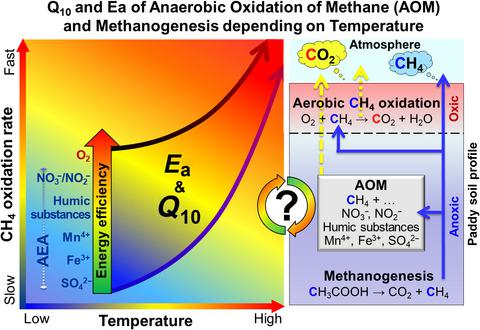当前位置:
X-MOL 学术
›
Glob. Change Biol.
›
论文详情
Our official English website, www.x-mol.net, welcomes your
feedback! (Note: you will need to create a separate account there.)
Temperature sensitivity of anaerobic methane oxidation versus methanogenesis in paddy soil: Implications for the CH4 balance under global warming
Global Change Biology ( IF 10.8 ) Pub Date : 2021-10-15 , DOI: 10.1111/gcb.15935 Lichao Fan 1 , Michaela A Dippold 2, 3 , Volker Thiel 4 , Tida Ge 5 , Jinshui Wu 5 , Yakov Kuzyakov 1, 6, 7, 8 , Maxim Dorodnikov 1, 2, 8
Global Change Biology ( IF 10.8 ) Pub Date : 2021-10-15 , DOI: 10.1111/gcb.15935 Lichao Fan 1 , Michaela A Dippold 2, 3 , Volker Thiel 4 , Tida Ge 5 , Jinshui Wu 5 , Yakov Kuzyakov 1, 6, 7, 8 , Maxim Dorodnikov 1, 2, 8
Affiliation

|
The global methane (CH4) budget is based on a sensitive balance between methanogenesis and CH4 oxidation (aerobic and anaerobic). The response of these processes to climate warming, however, is not quantified. This largely reflects our lack of knowledge about the temperature sensitivity (Q10) of the anaerobic oxidation of CH4 (AOM)—a ubiquitous process in soils. Based on a 13CH4 labeling experiment, we determined the rate, Q10 and activation energy of AOM and of methanogenesis in a paddy soil at three temperatures (5, 20, 35°C). The rates of AOM and of methanogenesis increased exponentially with temperature, whereby the AOM rate was significantly lower than methanogenesis. Both the activation energy and Q10 of AOM dropped significantly from 5–20 to 20–35°C, indicating that AOM is a highly temperature-dependent microbial process. Nonetheless, the Q10 of AOM and of methanogenesis were similar at 5–35°C, implying a comparable temperature dependence of AOM and methanogenesis in paddy soil. The continuous increase of AOM Q10 over the 28-day experiment reflects the successive utilization of electron acceptors according to their thermodynamic efficiency. The basic constant for Q10 of AOM was calculated to be 0.1 units for each 3.2 kJ mol−1 increase of activation energy. We estimate the AOM in paddy soils to consume 2.2~5.5 Tg CH4 per year on a global scale. Considering these results in conjunction with literature data, the terrestrial AOM in total consumes ~30% of overall CH4 production. Our data corroborate a similar Q10 of AOM and methanogenesis. As the rate of AOM in paddy soils is lower than methanogenesis, however, it will not fully compensate for an increased methane production under climate warming.
中文翻译:

稻田中厌氧甲烷氧化与产甲烷作用的温度敏感性:对全球变暖下 CH4 平衡的影响
全球甲烷 (CH 4 ) 预算基于产甲烷和 CH 4氧化(好氧和厌氧)之间的敏感平衡。然而,这些过程对气候变暖的反应尚未量化。这在很大程度上反映了我们对 CH 4 (AOM)厌氧氧化的温度敏感性 ( Q 10 )缺乏了解,CH 4 (AOM) 是土壤中普遍存在的过程。基于13 CH 4标记实验,我们确定了速率Q 10三种温度(5、20、35°C)下水稻土中 AOM 和产甲烷作用的活化能和活化能。AOM 和甲烷生成的速率随温度呈指数增加,其中 AOM 速率显着低于甲烷生成。AOM的活化能和 Q 10从 5-20°C 显着下降到 20-35°C,表明 AOM 是一个高度依赖温度的微生物过程。尽管如此,AOM 和甲烷生成的Q 10在 5-35°C 时相似,这意味着稻田中 AOM 和甲烷生成的温度依赖性相当。AOM Q 10的不断增加在为期 28 天的实验中,电子受体根据其热力学效率的连续利用。AOM 的Q 10的基本常数计算为活化能每增加3.2 kJ mol -1为 0.1 个单位。我们估计稻田土壤中的 AOM 在全球范围内每年消耗 2.2~5.5 Tg CH 4。结合文献数据考虑这些结果,陆地 AOM 总共消耗了总 CH 4产量的约 30% 。我们的数据证实了类似的Q 10AOM 和甲烷生成。然而,由于稻田土壤中 AOM 的速率低于产甲烷率,因此它不能完全补偿气候变暖下甲烷产量的增加。
更新日期:2021-12-13
中文翻译:

稻田中厌氧甲烷氧化与产甲烷作用的温度敏感性:对全球变暖下 CH4 平衡的影响
全球甲烷 (CH 4 ) 预算基于产甲烷和 CH 4氧化(好氧和厌氧)之间的敏感平衡。然而,这些过程对气候变暖的反应尚未量化。这在很大程度上反映了我们对 CH 4 (AOM)厌氧氧化的温度敏感性 ( Q 10 )缺乏了解,CH 4 (AOM) 是土壤中普遍存在的过程。基于13 CH 4标记实验,我们确定了速率Q 10三种温度(5、20、35°C)下水稻土中 AOM 和产甲烷作用的活化能和活化能。AOM 和甲烷生成的速率随温度呈指数增加,其中 AOM 速率显着低于甲烷生成。AOM的活化能和 Q 10从 5-20°C 显着下降到 20-35°C,表明 AOM 是一个高度依赖温度的微生物过程。尽管如此,AOM 和甲烷生成的Q 10在 5-35°C 时相似,这意味着稻田中 AOM 和甲烷生成的温度依赖性相当。AOM Q 10的不断增加在为期 28 天的实验中,电子受体根据其热力学效率的连续利用。AOM 的Q 10的基本常数计算为活化能每增加3.2 kJ mol -1为 0.1 个单位。我们估计稻田土壤中的 AOM 在全球范围内每年消耗 2.2~5.5 Tg CH 4。结合文献数据考虑这些结果,陆地 AOM 总共消耗了总 CH 4产量的约 30% 。我们的数据证实了类似的Q 10AOM 和甲烷生成。然而,由于稻田土壤中 AOM 的速率低于产甲烷率,因此它不能完全补偿气候变暖下甲烷产量的增加。











































 京公网安备 11010802027423号
京公网安备 11010802027423号